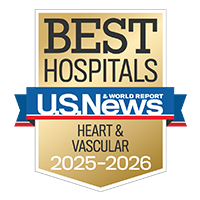Coronary Artery Disease

Overview
What is coronary artery disease (CAD)?
Coronary artery disease (CAD) is the leading cause of death in the United States and the most common type of heart disease. The condition develops when atherosclerosis – buildup of a sticky, fatty substance called plaque – narrows the arteries supplying blood to the heart. (Atherosclerosis is a type of arteriosclerosis, which is often referred to as "hardening of the arteries.")
When your heart doesn't receive enough oxygen-rich blood, you may feel pain or pressure in your chest, arm or jaw. This is a warning sign that your heart is having trouble functioning. If left untreated, CAD can lead to a heart attack.
Our approach to coronary artery disease
UCSF's heart specialists are leaders in preventing, diagnosing and treating coronary artery disease. We provide attentive, personalized care to people who may be at high risk, including those with high blood pressure, high cholesterol, or a family history of heart disease. We also see patients who are nearing middle age and worried that their lifestyle could be setting the stage for CAD.
Our CAD screening tools include laboratory tests to measure fat and cholesterol in the blood, imaging techniques that give doctors a window on the heart's function, and stress tests that show how the heart responds to exertion. We also offer a full range of heart disease prevention and treatment options, from medications and nutritional counseling to minimally invasive procedures and traditional surgery.
Our rapid mobilization team is on call 24 hours a day to respond quickly when someone has a heart attack. Once a patient is admitted to the UCSF Cardiac Critical Care Unit, they receive comprehensive, specialized treatment from a team that includes cardiologists, many other kinds of doctors, nurses, social workers, nutritionists, pharmacists, spiritual care providers, physical therapists and respiratory therapists.
Awards & recognition
-

Among the top hospitals in the nation
-

One of the nation's best for heart & vascular care
Symptoms of coronary artery disease
Over time, arteries severely narrowed by plaque (atherosclerosis) are no longer able to supply the heart with enough blood to function properly. As a result, you may develop angina, which is chest pain and other discomfort caused by insufficient blood flow. The pain is often described as strangling, squeezing or heavy. In addition to the chest, it may be felt in the shoulders, arms, neck, jaw, back or even the stomach.
In addition to angina, atherosclerosis can cause:
- Fatigue
- Shortness of breath
- An abnormal heartbeat or arrhythmia
The plaque buildup can also tear artery walls and form blood clots that can lead to a heart attack. Many people have no symptoms of coronary artery disease until they have a heart attack.
Causes of coronary artery disease
Certain physical and behavioral factors put some people at a higher risk of coronary artery disease. For example, men are generally at greater risk of developing CAD than women, but a woman's risk increases after menopause. Factors that can contribute to CAD include:
- Age. For men, the risk of developing CAD increases after age 55. The risk increases for women after age 65 or after they've gone through menopause.
- Diabetes. Patients with diabetes are two to four times more likely to develop CAD.
- Family history. If someone in your family had heart disease before age 50, you're at higher risk than average of developing it.
- High cholesterol. Cholesterol is a waxy substance in your blood that's mostly made by your liver but also comes from certain foods. Your body needs some cholesterol, but too much of certain types can lead to a dangerous accumulation of plaque in your arteries.
- High blood pressure. This is when the force of blood against blood vessel walls is too high. Over time, it can cause excessive strain on your heart and injure the lining of arteries.
- Obesity. Being overweight or obese increases the risk of CAD.
- Sedentary lifestyle. A lack of physical activity increases the risk of CAD.
- Smoking. Chemicals in cigarettes cause plaque to build up in the arteries over time.
- Stress. High levels of stress can increase blood pressure, cholesterol levels and other conditions commonly associated with CAD.
Diagnosis of coronary artery disease
Doctors assess patients by looking for atherosclerosis, which can be detected using various tests, including:
- Coronary angiography. This minimally invasive study is considered the gold standard for diagnosing CAD. Sometimes performed via cardiac catheterization (using a thin, flexible tube called a catheter to reach the heart), it can show whether the heart's blood vessels have narrowed, whether blood flow and the heart's pumping function are normal, and whether the heart's valves are working properly. It also can identify heart abnormalities that some people are born with.
- Computed tomography (CT) scan. This can show calcium deposits and blockages that are narrowing the arteries. To better reveal the location of the problems, a harmless dye that shows up on X-rays may be injected into a vein.
- Echocardiogram (ECHO). Sometimes referred to as a heart ultrasound, this noninvasive test uses sound waves to create pictures of your heart. It provides information about how the heart is pumping, how blood flows through the heart and blood vessels, how the valves are working, and the size of the heart.
- Electrocardiogram (ECG or EKG). An ECG records the heart's electrical activity using small electrodes that are placed with patches on your chest, arms and legs. The electrodes are connected by wires to a machine that records the flow patterns of electrical current in the heart. The test is used to diagnose arrhythmias and detect signs of heart damage.
- Exercise stress test. Also called a stress echocardiogram, this test shows how your heart performs when physically challenged. You'll exercise on a treadmill (or possibly a bicycle) while wearing ECG electrodes and wires so that your heart's electrical signals can be recorded.
- Nuclear stress test. Also known as a stress thallium test, this has two components, a treadmill stress test and a heart scan. First, a small amount of a harmless radioactive substance (hence the term nuclear) is injected into a vein. By tracking the substance with a special camera, doctors can view the coronary arteries, the heart's shape and function, and how blood flows through this system. This type of test has been used for many years to evaluate how much blood the heart is getting under various conditions, such as during exercise.
Treatment for coronary artery disease
Medications and lifestyle changes, such as quitting smoking or losing weight, can help the heart to function more efficiently and reduce angina, but they can't eliminate the plaque in the coronary arteries. Medications may include cholesterol-lowering drugs, beta-blockers, nitroglycerin, calcium channel blockers and angiotensin-converting enzyme (ACE) inhibitors.
Plaque removal for coronary artery disease
To reduce plaque in the arteries, doctors may perform a coronary artery bypass graft (CABG). This involves attaching an artery or vein from another part of the body to the clogged artery to create a detour for blood to go around a blockage. It's traditionally done through open-heart surgery, but UCSF offers a minimally invasive alternative, with benefits that include a shorter recovery time.
An alternative to CABG is a percutaneous coronary intervention, an approach that describes several minimally invasive procedures. These include:
- Angioplasty. A catheter with a tiny, folded balloon on its tip is threaded through a blood vessel until it reaches the site of the blockage. The balloon is inflated to flatten the plaque against the artery walls and widen the passageway.
- Angioplasty with stent. Often, as part of an angioplasty procedure, a stent (a tiny mesh tube) is placed in the problem area to keep the artery open and prevent plaque from building up again.
- Rotational atherectomy. Narrowed arteries are widened by sanding the plaque down with a high-speed rotating device. This technique is used for calcified (hardened) plaque buildup.
UCSF Health medical specialists have reviewed this information. It is for educational purposes only and is not intended to replace the advice of your doctor or other health care provider. We encourage you to discuss any questions or concerns you may have with your provider.

























